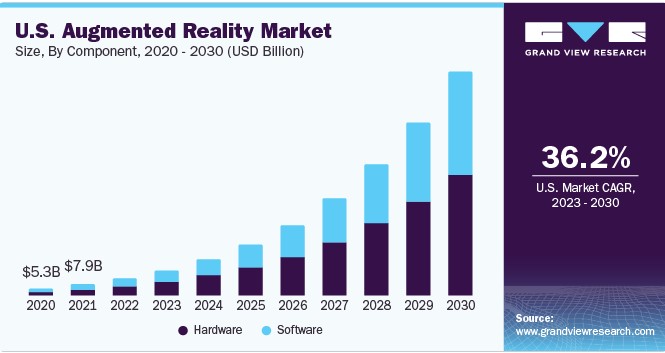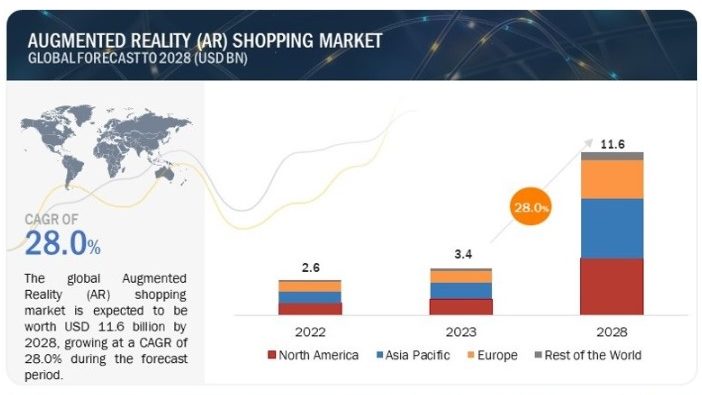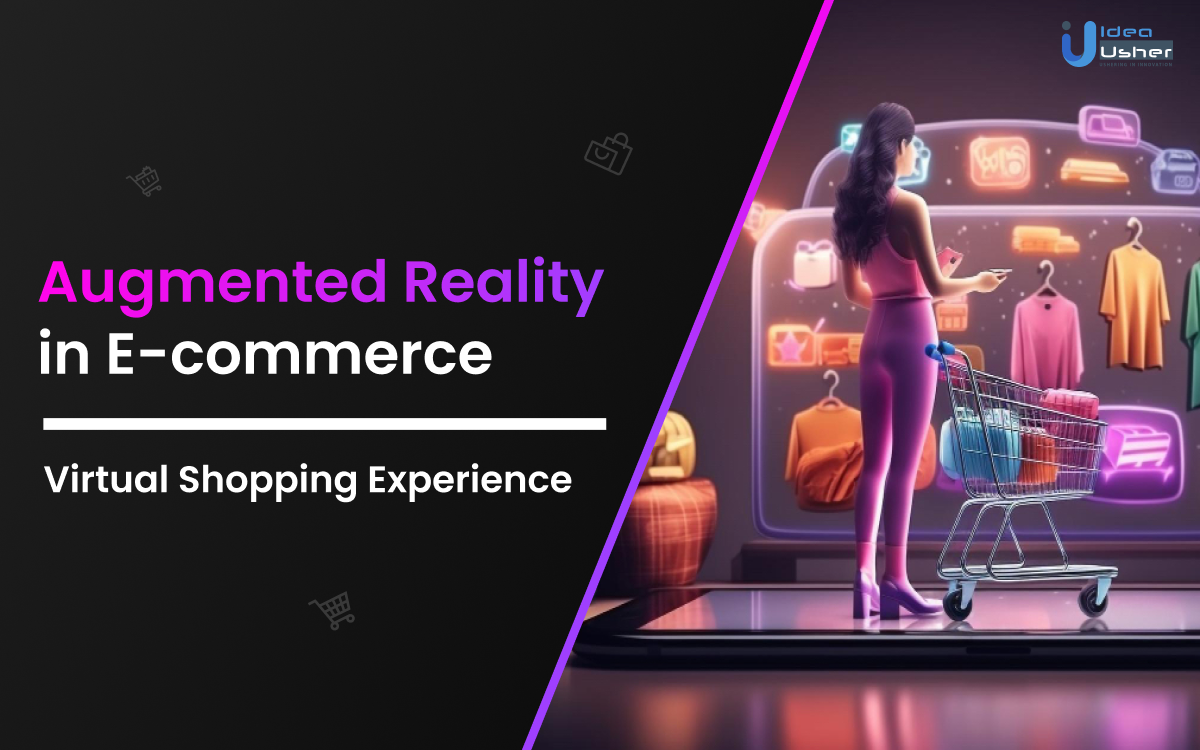When we talk about online shopping, one major hitch is missing out on the ‘hands-on feel’ that physical stores effortlessly provide. The absence of being able to touch or try out products before buying leaves shoppers unsure. However, there’s a game-changer on the horizon – the integration of Augmented Reality (AR) in e-commerce. This nifty tech lets users virtually interact with products, envisioning them in their own spaces. It’s like bringing the store to your doorstep. This not only fixes the downside of regular online shopping but also opens up exciting opportunities for businesses diving into AR-commerce. As companies embrace this transformative tech, they not only elevate the overall shopping experience but also tap into a growing market eager for a more engaging online retail journey.
What Is AR In E-commerce?
AR in e-commerce transforms the way we shop, giving us the ability to preview products or test services in our own space and on our own time before making a decision. This game-changing technology empowers us to confidently choose the perfect item from the get-go, reducing uncertainty and boosting satisfaction. With AR, we can explore and interact with potential purchases in a way that suits our preferences, ensuring a more informed and enjoyable shopping experience.
The rise of augmented reality effectively bridges the gap between traditional stores and the virtual world of online shopping. AR has seamlessly integrated into various e-commerce sectors, from transforming interior design experiences to making waves in the fashion industry. It has proven to be a lasting and impactful addition to the digital retail segment.
Here are some well-known brands that have embraced Augmented Reality (AR) to enhance their shopping experiences:
1. Adidas
Adidas, the German sportswear brand, took a forward-thinking approach by introducing its Deerupt sneaker through AR before the physical launch.
2. Burberry
Burberry, the London-based luxury fashion house, collaborated with Apple to introduce a unique feature in its mobile app. This feature enables users to incorporate Burberry-inspired illustrations by artist Danny Sangra into their iPhone camera feeds.
3. Converse
Converse allowed customers to virtually test a wide array of its online catalog through The Sampler, an app introduced in 2010.
4. Gap Inc.
Addressing a common challenge for mobile shoppers, Gap devised a solution with its DressingRoom app. This innovative app allows users to virtually try on styles and assess how they fit on their bodies.
5. Nike, Inc.
Taking a step further, Nike seamlessly integrated AR shopping into social media platforms, enabling users to personalize and virtually try on a pair of Nike Air Force 1s.
Augmented Reality (AR) enhances real-world environments by overlaying digital information in a seamless manner. It integrates computer-generated elements, such as images or data, into the user’s perception of the physical world, providing an interactive and immersive experience that combines the virtual and real, often accessed through mobile devices or smart glasses.
How Augmented Reality In E-commerce Works?
Augmented Reality (AR) in e-commerce unfolds a transformative narrative, and here’s a comprehensive breakdown of how AR operates within the e-commerce landscape:
1. Immersive Product Visualization
AR empowers customers to visualize products authentically in their real-world settings, leveraging smartphones or AR-enabled devices. This dynamic feature allows users to preview furniture, apparel, and other items in their homes or on themselves before committing to a purchase.
2. AR Applications and Platforms
Retailers develop dedicated AR applications or leverage existing AR platforms, offering customers downloadable tools for their smartphones or tablets. These applications utilize device cameras and sensors to overlay digital layers onto the tangible world.
3. Marker-based AR
Some AR systems utilize markers like QR codes or images as reference points for digital overlays. When detected by the camera, these markers trigger the display of associated digital content, enhancing the user’s interactive experience.
4. Markerless AR
Markerless AR harnesses device sensors, including GPS, accelerometers, and gyroscopes, eliminating the need for specific markers. This approach ensures a seamless and natural AR encounter by comprehending the user’s surroundings.
5. Virtual Try-Before-You-Buy
AR redefines the online shopping paradigm by enabling customers to virtually try on products like clothing, accessories, or makeup. This mitigates uncertainty, establishing increased confidence and satisfaction.
6. Interactive Product Information
AR serves as an informative ally, providing interactive details about products. Pointing the device at a product may unveil specifications, reviews, or instructional videos, offering a rich and immersive shopping journey.
7. Increased Engagement
Integrating AR into e-commerce fuels heightened customer engagement. The allure of interactive and visually captivating experiences encourages users to spend more time on the platform, significantly elevating conversion prospects.
8. Innovative Marketing Campaigns
AR becomes a linchpin in marketing campaigns, facilitating interactive and memorable experiences. Retailers leverage AR for virtual try-on initiatives or gamified experiences, injecting creativity into promotional efforts.
9. Integration With Online Platform
E-commerce platforms seamlessly integrate AR features into their interfaces, allowing users direct access to AR experiences without relying on external applications.
10. AR-powered Shopping Assistance
Some e-commerce platforms use AR to offer virtual shopping assistants. These assistants can help users find products, compare options, and make informed decisions.
Market Stats Of AR In E-commerce
In 2022, the global augmented reality market was valued at USD 38.56 billion, with a projected compound annual growth rate (CAGR) of 39.8% anticipated from 2023 to 2030.

Projections indicate that the Augmented Reality (AR) shopping market is set to grow significantly, reaching USD 11.6 billion by 2028, up from USD 3.4 billion in 2023. This represents a Compound Annual Growth Rate (CAGR) of 28.0% during the forecast period.

Factors Driving The Rise Of AR In E-commerce
In driving the increased adoption of Augmented Reality (AR) within e-commerce, several key factors play a pivotal role, shaping a notable shift in the digital shopping sphere:
1. Improved Shopping Experience
The recognized utility of AR stands out as a major factor. AR doesn’t just entertain and educate but markedly enhances the shopping journey. It seamlessly combines entertainment and education, offering customers an engaging way to evaluate products with unprecedented depth.
2. Customer-centric Experiences
A growing demand from consumers propels AR into the limelight. Shoppers increasingly seek immersive and informative experiences. AR responds by delivering nuanced product information, conveniently empowering customers from the comfort of their homes.
3. Competitive Dynamics
The competitive pressure from early AR adopters prompts others to follow suit. As businesses across different sectors embrace AR, the e-commerce landscape undergoes a paradigm shift. To stay relevant, companies feel compelled to seamlessly integrate AR, enhancing competitiveness and meeting evolving consumer expectations.
4. Customer Expectations
A crucial factor is the evolving expectation of customers for more than a mere transaction – they desire an immersive, interactive shopping journey. AR aligns with this demand, providing an experiential edge that traditional online shopping often lacks.
5. Technological Proficiency
The proficiency of a company in navigating and leveraging technological advancements directly influences its success in AR integration. Companies with a solid technological foundation find it easier to implement and sustain AR technologies, staying ahead in the ever-evolving digital landscape.
6. Cost Implications
While the potential of AR is significant, the perceived cost remains a substantial consideration. Businesses weigh the investment required for developing and maintaining AR experiences against the anticipated benefits. The perceived cost, therefore, acts as both a motivator and a potential deterrent for AR adoption.
Despite these influencing factors, a noteworthy observation is that many retailers, perhaps due to various considerations, remain cautious about fully embracing AR within their shopping experiences. It becomes imperative for businesses to conduct thorough analyses, understanding both the advantages and challenges associated with AR adoption before embarking on substantial projects. This strategic approach ensures a well-informed and effective integration of AR, aligning with the dynamic needs of e-commerce.
Why Should Businesses Invest In AR Integration In E-commerce?
Investing in Augmented Reality (AR) within e-commerce opens doors to several advantages for businesses, shaping the future of online retail in distinct ways:
1. Enhanced Shopping Experience
AR goes beyond traditional online shopping, allowing customers to virtually engage with products as if they were in a physical store. This immersive approach enhances the overall shopping journey and tailors it to the individual preferences of each customer.
2. Increased Conversion Rates
Integrating AR experiences can lead to a significant 94% surge in conversion rates in specific scenarios. This impactful transformation highlights the compelling ability of AR to convert virtual interactions into actual transactions.
3. Customer Engagement
AR serves as a versatile tool, offering additional information, enriching learning experiences, and introducing novel forms of entertainment. This heightened engagement deepens the connection between customers and products, creating a more interactive and memorable online shopping environment.
4. Meeting Customer Expectations
As customer expectations continually evolve, e-commerce enterprises must strategically evaluate how AR integration aligns with and surpasses these changing demands. This adaptability ensures businesses remain not just relevant but also competitive in the dynamic market landscape.
5. Market Growth
The AR market is experiencing rapid expansion, evidenced by the impressive valuation of the US augmented, virtual, and mixed reality market. With a worth of $28 billion in 2021, projections anticipate a significant surge to over $250 billion by 2028. Investing in AR aligns businesses with this growing market trend, ensuring they ride the wave of technological advancement.
6. Attracting Younger Consumers
A significant 92% of Generation Z expresses a strong interest in using AR for their shopping experiences. This demographic inclination signifies a pivotal shift, indicating that younger consumers are poised to lead the widespread adoption of AR technology within the e-commerce realm.
How Can AR Technology Be Leveraged In Commercial Settings?
Augmented reality (AR) technology has various types, each with unique capabilities. Here’s a breakdown of prevalent AR applications in commercial settings:
1. Marker-based AR
Also known as Image Recognition or Recognition-based AR, Marker-based AR identifies a specific object, termed the “marker,” through the device’s camera. Once the AR application detects this marker, it superimposes a 3D representation of the corresponding object on the screen. Users can then explore the object in greater detail and from various perspectives, enhancing their interactive experience.
2. Markerless AR
Unlike its marker-based counterpart, Markerless AR operates without needing a predefined object. Users can place virtual objects freely in their surroundings, allowing them to rotate and relocate these digital entities. This type of AR eliminates the dependency on specific markers, providing a more spontaneous and adaptable user experience.
3. Superimposition-based AR
Superimposition-based AR enhances real-world views by overlaying digital information onto them. This type often involves providing additional details about objects or scenes in the user’s line of sight. For instance, using a smartphone camera, users can point the device at a historical landmark to receive relevant historical information superimposed on the screen.
4. Location-based AR
A subset of markerless AR, Location-based AR leverages geographic data to display digital content at specific physical locations. A prime example of this is the phenomenon witnessed in games like Pokemon Go, where digital elements are seamlessly integrated into real-world locations, creating an immersive and location-aware user engagement.
5. Recognition-based AR
Recognition-based AR focuses on identifying and providing information about real-world objects or images. Through image recognition technology, users can point their devices at objects, and the AR application can retrieve and display relevant details about the recognized items. This type is particularly useful in applications ranging from art exhibits to educational tools.
6. Projection-based AR
Projection-based AR involves projecting synthetic light onto tangible surfaces, enabling users to interact with the projected elements. This dynamic form of AR often brings to mind the holographic displays featured in sci-fi classics such as Star Wars. By merging the virtual with the physical, projection-based AR opens avenues for interactive and visually captivating experiences.
7 Key Considerations For AR Integration In E-commerce Applications
Here are some critical factors to evaluate before implementing augmented reality in e-commerce applications:
1. Validation of Use Case
Verify AR’s fit for products like furniture or clothing, where visual confirmation elevates the shopping experience, influencing consumer decisions and fostering engagement and satisfaction.
2. 3D Modeling
Secure top-notch 3D product models, pivotal for an enriched AR experience. Recognize their impact on overall user satisfaction, ensuring heightened engagement through visually appealing and accurate representations.
3. AR Integration
Strategically integrate AR into your application, choosing platforms like ARKit (iOS), ARCore (Android), or WebAR for web-based experiences. Ensure a cohesive implementation that aligns with your application’s objectives.
4. User-Centric Experience
Prioritize an intuitive and user-friendly AR interface, facilitating effortless navigation and interaction within the augmented environment. Enhance positive user satisfaction by delivering an enjoyable AR shopping experience.
5. Optimized Performance
Enhance your application’s performance to address resource-intensive demands, guaranteeing a smooth and responsive AR encounter that contributes to user satisfaction and engagement.
6. Financial Considerations
Be mindful of the associated costs, covering 3D model creation, AR integration, and ongoing maintenance. Understand the financial investment required for a successful AR implementation, aligning it with your e-commerce business strategy and goals.
7. Legal Considerations
Address potential legal considerations concerning intellectual property rights and data privacy in the evolving segment of AR technology and e-commerce. Ensure compliance, mitigate risks associated with legal complexities, and safeguard user and business interests.
17 Key Features For AR E-commerce App
Creating a successful AR e-commerce app requires careful consideration of features that enhance the user experience and facilitate seamless interactions between the virtual and physical worlds. Here are some important features of an AR shopping app:
1. Product Visualization
Enable users to preview furniture, clothing, or home decor in their space seamlessly using AR. This immersive experience aids decision-making by visualizing products in real-world environments.
2. Virtual Try-On
Implement a virtual try-on feature for clothing, accessories, or makeup. Users can confidently assess product suitability by virtually trying them on through the app.
3. Markerless AR
Ensure a natural AR experience by supporting markerless technology. Users can interact intuitively without the need for markers or QR codes, enhancing overall user engagement.
4. Real-Time Interaction
Facilitate dynamic real-time interaction between the app and users’ surroundings. Immediate reflection of changes in the physical environment within the AR visualization ensures a seamless and responsive experience.
5. Social Signup and Login
Simplify user registration by offering social media login options. Quick and non-intrusive signup processes enhance user engagement, reducing barriers and potential drop-offs.
6. Product Information Overlay
Enhance user knowledge with a product information overlay. When users point their devices at items, they receive detailed information, prices, reviews, and direct links for convenient and informed decision-making.
7. Wishlist and Shopping Cart Integration
Streamline the purchase process by enabling users to add AR-visualized products directly to their wishlist or shopping cart. This integration enhances user convenience and encourages seamless transactions.
8. AR Shopping Assistant
Implement a virtual shopping assistant guiding users through the AR shopping journey. This intelligent assistant offers personalized recommendations, answers queries, and assists users throughout the purchase process.
9. Offline Mode
Enhance user accessibility with an offline mode, allowing access to previously visualized products or saved AR experiences without an internet connection. This feature ensures continuous engagement regardless of connectivity.
10. Multi-Platform Support
Ensure broad accessibility by supporting various devices, including smartphones, tablets, and potentially AR glasses. Multi-platform compatibility expands the app’s reach, catering to a diverse user base.
11. Secure Checkout
Prioritize user security with a robust and user-friendly checkout process. A secure payment gateway ensures user confidence and a seamless transition from AR exploration to product purchase.
12. User Profiles and Personalization
Create personalized user profiles to store preferences and past AR interactions. Utilize this information to customize the AR shopping experience, providing users with curated product recommendations.
13. Feedback and Ratings
Build trust and continuous improvement by allowing users to leave feedback and ratings. Valuable insights from user reviews contribute to app enhancement and build a sense of transparency.
14. Integration with Existing Platforms
Leverage existing e-commerce platforms by seamlessly integrating the AR shopping app. This integration optimizes product catalogs, user accounts, and payment systems, providing a unified and efficient shopping experience.
15. AR Catalog Mode
Provide a separate catalog mode allowing users to view products with detailed specifications. Include features such as favorites, search options, well-written product descriptions, references to product pages, multilingual information availability, a vast number of items, seamless navigation, and high-class design.
16. AR Shopping App – AR Mode
Enhance the user experience with AR mode, enabling customers to experience products in their homes. Feature 3D model projections, manipulation options (move, rotate, scale), room dimensions scanning, special AR models with a printed catalog, and precise positioning in the iOS app due to ARKit use.
17. Search Products in Physical Store
Implement an augmented reality product navigator for physical stores. Allow users to filter products based on dimensions, price, color, type, country of origin, size, manufacturer, and seller details.
How To Integrate AR In E-commerce Applications?
The integration of augmented reality (AR) in e-commerce has emerged as a compelling solution to bridge the gap between in-person and online shopping experiences. AR can enhance customer engagement, satisfaction, and product representation while reducing return rates and costs. Here is a step-by-step guide to implementing AR in e-commerce:
1. Establish Clear Objectives
Define precisely what you aim to achieve with AR. Whether it’s enhancing product visualization or enabling virtual try-ons, clarity in goals ensures a focused and impactful AR experience for your customers. If, for instance, the goal is enhanced product visualization, specify the desired level of detail and interactivity. In virtual try-on scenarios, outline criteria such as accurate sizing and realistic garment movement. For example, if you sell furniture, envision customers virtually placing items in their homes to gauge suitability.
2. Choose User-Friendly AR Tools
When selecting AR tools, consider not just the budget but also the development ecosystem. Evaluate the scalability of the chosen AR platform for future updates. For device compatibility, delve into specific hardware specifications to ensure optimal performance. When assessing capabilities, identify how well the platform handles real-time rendering and whether it supports AR-specific functionalities like marker-based interactions. You can select ARKit or ARCore based on your target audience’s predominant mobile device.
3. Effective Marketing Strategies
Promote your AR tool with engaging demo videos. Implement clear in-app instructions and make content shareable. Enhance visibility through strategic marketing, emphasizing the unique benefits of your AR features. Beyond creating demo videos, implement SEO-friendly metadata in your video descriptions. In-app instructions should be contextual, adapting to user interactions. Integrate social media APIs for seamless content sharing, ensuring your AR experiences become shareable assets.
4. High-Quality 3D Models
Begin by creating detailed 3D models of your products. These models serve as the foundation for an immersive AR experience, offering customers a lifelike preview of your merchandise.
Invest in photorealistic 3D modeling tools like Blender or Maya for product representation. Optimize models for AR by reducing polygon count while preserving visual fidelity. Use PBR (Physically Based Rendering) materials for realistic lighting and shading effects. You can implement LOD (Level of Detail) techniques for dynamic model optimization, enhancing AR performance across a spectrum of devices.
Example: For jewelry or fashion sellers/brands, intricate 3D models showcase details, improving the virtual shopping experience.
5. Seamless AR Integration
Utilize AR plugins or SDKs that are customized for e-commerce. Integrate features like preview item placement, ensuring customers can visualize products in their surroundings effortlessly. Leverage AR frameworks like ARKit or ARCore based on the target platform. Integrate AR features with APIs, facilitating real-time communication between the app and AR content. Implement responsive UI elements that seamlessly transition between standard and AR experiences and WebAR for a user-friendly, browser-based AR experience.
6. User-Friendly Interface
Prioritize an intuitive interface. Customers should navigate effortlessly between standard shopping and AR features. Employ AR-specific UX principles, incorporating gestures like pinch-to-zoom or swipe for intuitive interactions. Implement touch event handling optimized for AR navigation. For this, you can employ gesture recognition libraries such as Leap Motion for precise user interactions within the AR environment. Additionally, you can utilize UI/UX design tools like Sketch or Figma for a cohesive interface.
7. Optimize for Device Performance
Design AR features for various devices, optimizing for different screen sizes. Test extensively on smartphones and tablets to guarantee a consistent, high-quality experience. Implement adaptive UI layouts for responsiveness. Utilize performance profiling tools like Xcode Instruments or Android Profiler to identify bottlenecks and optimize resource utilization.
8. Performance Optimization
Streamline AR performance by optimizing rendering times and reducing latency. Smooth animations are vital for a responsive and enjoyable user experience. Additionally, you can optimize AR performance by employing techniques like asset bundling for efficient resource loading. Implement occlusion culling to enhance rendering efficiency. Utilize asynchronous loading for AR content to minimize latency. You can apply shader optimization techniques, such as using Shader Graph in Unity, to enhance graphic performance in AR.
9. Thorough Testing Protocols
Conduct rigorous testing using emulators and physical devices across different OS versions and network conditions. Implement automated testing scripts for repetitive scenarios. Leverage AR-specific testing tools like AR Testing Playground for dynamic testing scenarios. Identify and rectify any bugs or glitches for a flawless AR experience. You can employ ARCloud solutions to simulate diverse real-world environments during testing, ensuring robust performance under varied conditions.
10. Implement Robust Security Measures
Prioritize user data security, especially for transactions. Encrypt AR data transmissions using industry-standard protocols like TLS. Implement secure authentication mechanisms for user interactions. Regularly audit third-party libraries used for potential security vulnerabilities. You can utilize certificate pinning to enhance the security of data exchanged between the AR app and servers and employ SSL encryption to secure data during AR interactions, enhancing user trust.
11. Provide Clear User Guidance
Implement AR-specific tooltips and tutorials using AR authoring tools. Utilize AR frameworks’ built-in guidance features. Employ machine learning algorithms for user behavior analysis to enhance adaptive guidance. Furthermore, you can implement tooltips for seamless user guidance. Moreover, you can use ARKit’s ARCoachingOverlayView, particularly in iOS apps, to provide real-time instructions and guidance.
12. Continuous Improvement Through Feedback
Establish a systematic feedback loop using analytics tools like Firebase or Mixpanel. Utilize A/B testing methodologies to assess the impact of AR feature variations. Furthermore, you must encourage user feedback for continual refinement, address concerns promptly, and leverage user suggestions to enhance the overall AR experience. To achieve this, you can create a user feedback loop, rewarding users for valuable insights that contribute to AR feature improvements and, at the technical end, implement sentiment analysis on user feedback using natural language processing (NLP) algorithms for nuanced insights into user sentiments regarding AR experiences.
Tech Stack For Integrating Augmented Reality In E-commerce Applications
| Features | Description |
| Programming Languages | JavaScript (for cross-platform development)Swift (for iOS)Kotlin (for Android) |
| AR Frameworks | ARKit (for iOS)ARCore (for Android) |
| 3D Modeling Tools | BlenderUnity |
| Backend Development | Node.js or Django |
| Cloud Services | AWS (Amazon Web Services)Azure (Microsoft Azure) |
| APIs | ARCloud APIs (for persistent AR experiences)Payment gateways APIs for transactions |
| Frontend Technologies | React or Vue.js (for user interface and experience) |
Examples Of Augmented Reality (AR) Transforming The Shopping Experience
Several compelling examples of augmented reality (AR) applications within the e-commerce domain underscore the transformative influence of this technology on customer experiences and sales. Here are the five noteworthy examples:
1. Amazon

Estimated Annual Revenue: $538.13 billion
The Amazon mobile app incorporates AR functionality, empowering customers to visualize furniture and various products within their living spaces. By leveraging AR, Amazon not only elevates the overall shopping experience but also mitigates the likelihood of product returns, demonstrating the practical applications of this technology. Some of the ways Amazon uses
AR to enhance the shopping experience include:
1.1. Virtual Try-On
Amazon Fashion launched a virtual try-on feature for shoes, featuring brands such as Adidas, Reebok, New Balance, and Puma. Subsequently, the company collaborated with Snapchat to unveil a virtual try-on tool for eyewear, enabling customers to experiment with brands like Oakley, Persol, and Costa Del Mar.
1.2. View in Your Room
Amazon’s “View in Your Room” tool utilizes AR to allow customers to place realistic 3D images of home furnishings into a virtual space, giving them a better sense of how the products would look in their own environment. This feature also enables customers to change the color of virtual room elements and products, enhancing the visualization of potential purchases.
2. IKEA Place

Estimated Annual Revenue: €47.6 billion
IKEA’s AR app, aptly named IKEA Place, enables users to virtually position products in their homes, offering a realistic preview of how items would fit into their living spaces. This immersive AR experience contributes to a reduction in return rates and an enhancement in overall customer satisfaction, illustrating the potential of AR to influence purchasing decisions positively. Here are some examples of how IKEA has been using AR:
2.1. IKEA Place App
The IKEA Place app allows customers to take a picture of a place in their house and virtually place IKEA furniture there to see how it fits the room. Users can select a piece of IKEA furniture from the provided catalog and place it on the floor, which acts as an anchor where the 3D version of the furniture is projected. By having an AR app specifically accessible from smartphones, IKEA Place contributes significantly to the growth of IKEA. The app helps increase user engagement rates by providing features that grant consumers the ability to visualize products in their own space before making a purchase.
2.2. IKEA Studio App
IKEA’s design division, Space10, has enhanced IKEA’s AR application for a more practical and engaging encounter. Formerly, the IKEA Place app permitted users to position virtual furniture in a space. With the latest IKEA Studio app utilizing LiDAR sensors in iPhones, users can now capture complete 3D room layouts and remodel them, simplifying the process of envisioning and organizing home decor for customers.
2.3. IKEA Catalog App
IKEA’s 2014 printed catalog featured an augmented reality capability that allowed customers to view and place virtual furniture to scale in their own homes. Users scanned selected pages in the catalog with the IKEA Catalog app, which provided a unique experience, allowing users to experience new furniture to scale in their own homes. The app unlocked 50 pages of digital content, including videos, furnishing tips, and room designs, providing customers with valuable information to make informed purchasing decisions.
3. Saatchi Art

Estimated Annual Revenue: $128.6 million
Saatchi Art harnesses AR to empower customers to virtually showcase and customize artwork within their living environments before making a purchase. This interactive feature aids customers in visualizing the aesthetic impact of specific art pieces in their spaces, fostering a connection that increases the likelihood of successful transactions. Here are some examples of how Saatchi Art has been using AR:
3.1. Immersive Art Preview with “Visualize in My Space”
Saatchi Art pioneers an impactful use of augmented reality (AR) with its “Visualize in My Space” feature, offering users a captivating preview of over 1.4 million art pieces within the context of their living environments. This innovative functionality, seamlessly integrated into the Saatchi Art website, empowers users to handpick artworks and instantly project them onto their walls through the lens of their smartphones or tablets. By harnessing AR in this manner, Saatchi Art effectively addresses the common apprehension of online art buyers, providing a tangible solution for inspecting artworks before committing to a purchase.
3.2. Adaptive 3D Canvases for Versatile Viewing
Saatchi Art’s AR solution goes beyond the ordinary by handling a vast repository of over 1.4 million image files. The focus lies in the adept processing and display of individual art pieces, with the AR technology dynamically adjusting the scale of each artwork based on its unique dimensions. This adaptive approach ensures that the virtual rendition of the artwork aligns accurately with size and proportions within the user’s physical space, heightening the realism and practicality of the AR encounter.
3.3. Precision Enhancement with WebAR Proximity Indicator
Elevating the AR experience, Saatchi Art incorporates a WebAR proximity indicator into its feature set. This sophisticated functionality meticulously analyzes the user’s positioning in the 3D scene, issuing warnings when the user approaches too closely to the showcased artwork. By introducing this precision enhancement, Saatchi Art ensures that users engage with the virtual art at an optimal distance, mimicking an authentic viewing encounter while averting potential visual distortions or discomfort. This meticulous attention to detail underscores Saatchi Art’s commitment to delivering an immersive and user-centric platform for art exploration and acquisition.
4. Warby Parker

Estimated Annual Revenue: Between $645 million and $660 million
Warby Parker employs AR technology in its application, allowing users to virtually try on eyewear and obtain a more accurate representation of how glasses complement their facial features. This immersive feature has proven to be a catalyst for increased sales and heightened customer satisfaction. Here is how Warby Parker has effectively utilized augmented reality (AR) to enhance the shopping experience for its customers:
4.1. Virtual Try-On App
Warby Parker’s official app allows users to try on a pair of their glasses virtually using AR. This feature enables users to see how the glasses look on their faces, providing a more immersive and informative shopping experience. The app is outfitted with Apple Pay integration and SMS updates for shipping, offering a seamless experience.
4.2. AR Technology
The virtual try-on feature utilizes the iPhone selfie camera as well as Apple’s ARkit and True Depth technology, allowing customers to realistically visualize how certain textures, frames, and colors will look on their faces. The placement algorithm mimics the real-life process of taking into account how unique facial features interact with the frame, providing an accurate representation.
5. Sephora

Estimated Annual Revenue: $10 billion
Sephora’s AR application introduces a virtual makeup try-on feature, empowering customers to visualize how different makeup shades would appear on their skin. This engaging functionality not only boosts conversions but also contributes to a reduction in product refunds, showcasing the potential of AR to enhance the cosmetics shopping experience. Here are some examples of how Sephora has been using AR:
5.1. Real-time Facial Mapping Innovation
Sephora employs cutting-edge augmented reality (AR) through advanced facial mapping technology, ensuring precise mapping of users’ facial features. This sophisticated technology realistically applies makeup products in real-time, offering customers an accurate preview of how the products will appear on their unique facial contours. The system takes into consideration the distinctive features of each user’s face, elevating the virtual try-on experience to a new level of accuracy and realism.
5.2. Incorporation of Virtual Artist Feature
Within the Sephora app, the Virtual Artist feature takes center stage, enabling customers to experiment with makeup virtually using their smartphones or tablets. Powered by AR, this feature allows users to visualize the impact of various makeup products on their skin without the need for physical application. The Virtual Artist empowers customers to explore different makeup options and styles, contributing to an enriched shopping experience and bolstering confidence in their purchasing decisions.
5.3. Live Facial Recognition Integration
Sephora’s AR technology goes a step further with the integration of real-time facial recognition, enhancing the virtual try-on experience. This feature facilitates users in trying products with live 3D movement, improved facial tracking, and more accurate rendering. Leveraging real-time facial recognition adds dynamism and interactivity to Sephora’s virtual makeup application, effectively narrowing the gap between traditional in-store and online shopping experiences.
5.4. AR Initiatives Efficacy Metrics
Sephora SEA, the Southeast Asian arm of Sephora, reported a notable 28% surge in user adoption and a substantial 48% increase in overall traffic to the AR feature. These metrics underscore the success of Sephora’s AR initiatives in captivating and attracting customers. The positive impact on user adoption and traffic signifies the exact value that AR technology brings to the beauty retail experience, establishing Sephora as a frontrunner in utilizing AR for enhanced customer engagement and satisfaction.
Here are 10 more notable instances demonstrating how Augmented Reality (AR) transforms the shopping experience:
- IKEA Creative Vision: IKEA’s Creative Vision enables users to craft a lifelike 3D replica of their room on iPhones using LiDAR technology. Following the scan, customers can effortlessly replace existing furniture and explore novel products.
- Toyota AR Customization: Toyota employs AR for an advanced vehicle customization encounter. Shoppers seeking car accessories utilize AR to visualize diverse options.
- Nike’s Interactive Showcase: Nike employs WebAR in retail to elevate customer engagement and confidence. Through Nike’s Interactive Showcase, customers can actively engage, personalize, and make informed purchase decisions.
- Sephora’s Virtual Makeup Try-On: Sephora’s AR app enables users to virtually test various makeup products, aiding informed purchase decisions.
- Lacoste Virtual Shoe Fitting: Lacoste’s AR app invites customers to try on shoes virtually, delivering a distinctive and captivating shopping experience.
- Ray-Ban Sunglass Simulation: Ray-Ban’s AR app empowers customers to virtually test different sunglasses, assisting in choosing the ideal pair.
- Gucci Virtual Shoe Fitting: Like Lacoste, Gucci’s AR app also allows customers to try on shoes virtually.
- Timberland’s Virtual Fitting Room: Timberland’s AR app offers a virtual fitting room for trying on clothes.
- Topshop’s Kinect Dressing Room: Topshop’s AR app invites customers to virtually try on clothes.
- Converse Virtual Sampler: Converse’s AR app enables customers to virtually try on shoes, offering an engaging and informed shopping experience.
6 Legal Considerations For AR In E-commerce Applications
Incorporating Augmented Reality (AR) into e-commerce brings thrilling possibilities, but it also brings legal complexities that demand careful consideration. As an AR expert, it’s crucial to navigate these legal challenges to ensure compliance and minimize risks. Here are key legal issues to consider:
1. Protecting Intellectual Property (IP) in AR Systems
AR apps involve various intellectual property elements, including copyrights, trademarks, and patents. Copyrights cover items like maps and codes, while trademarks safeguard names and logos. Patents extend protection to AR processes and functionality. Robust IP strategies and legal frameworks are essential for safeguarding these rights.
2. Contracts and Licenses for IP Protection
Beyond statutory IP protection, using contracts effectively is crucial. Establish comprehensive Terms of Service (TOS) and robust Data Licenses and Terms of Use to fortify IP safeguards. Well-crafted contracts act as vital supplements to traditional IP protection.
3. Technological Measures for IP Enhancement
Implementing technological measures enhances IP protection. Data Rights Management (DRM), watermarking, and access limitations are effective tools to deter infringement and unauthorized use.
4. Regulatory Ambiguity and AR Misuse
The absence of specific regulations governing AR creates a legal gray area. This ambiguity opens avenues for both constructive and malicious applications. Navigating this landscape requires a cautious approach, with constant monitoring for potential misuse.
5. Data Privacy and Consumer Protection Challenges
E-commerce AR must grapple with intricate data privacy and consumer protection issues. Balancing personalization with privacy compliance under regulations like GDPR, CCPA, and HIPAA is paramount. Striking this delicate balance is essential for maintaining legal integrity.
6. Mandatory Disclosures and Regional Compliance
Legal requirements differ by region, and adherence to regional laws is imperative. Some regions mandate specific disclosures; for instance, California’s Bot Disclosure Act requires retailers to identify chatbots to consumers. Awareness and compliance with such regional nuances are critical.
Note: Keep in mind these represent only a subset of conceivable legal challenges. It’s advisable to seek guidance from a legal professional during the creation of an AR e-commerce application to guarantee adherence to applicable laws and regulations.
Difference Between Augmented Reality And Virtual Reality
The phrases “augmented reality” (AR) and “virtual reality” (VR) are often employed interchangeably, yet their differences hold substantial significance. The contrast between augmented reality and virtual reality extends beyond their immersive characteristics, encompassing considerations such as accessibility, portability, and equipment requisites. These factors render each technology distinctively tailored to a variety of user experiences and preferences.
| Aspect | Augmented Reality (AR) | Virtual Reality (VR) |
| Immersiveness | Augments real-world environment | Immerses users in a digitally created world |
| Interaction with the Real World | Integrates digital content into reality | Isolates users from the real world |
| Portability | More portable, often using smartphones or AR glasses | Equipment-dependent, requires headsets and controllers |
| Use Cases | Enhances real-world experiences | Transforms into entirely new environments and experiences |
| Accessibility | More accessible with minimal equipment requirements, suitable for a broader audience including smartphone users | Limited accessibility due to exclusive equipment demands, catering to a more niche audience |
| Mixed Reality (MR) | Merges digital and physical worlds, providing a continuum between AR and VR | Encompasses a spectrum from partial to fully immersive virtual experiences |
| Real-Time Interaction | Allows real-time interaction with both digital and physical elements simultaneously | Enables real-time interaction within the virtual environment |
| Applications | Commonly used in AR navigation, product visualization, and educational tools | Widely utilized in gaming, simulations, virtual tours, and immersive training |
| Training and Simulation | Valuable for practical training scenarios, offering hands-on experience in real-world settings | Ideal for simulations and training in controlled, virtual environments |
| Technological Requirements | Relies on less complex technology, often using existing devices like smartphones | Requires specialized and advanced hardware such as VR headsets and controllers |
| Social Interaction | Supports social interaction in real-world settings, enabling shared augmented experiences | Often isolates users from physical surroundings, limiting real-world social interaction |
Conclusion
Augmented reality (AR) is revolutionizing the e-commerce industry by offering immersive and interactive shopping experiences that bridge the gap between online and offline shopping. AR allows customers to preview products or experience services in their own environment, on their own time, and with stunning realism. It is being used to enhance product visualization, improve customer engagement, enable personalized shopping, and boost conversion rates. AR is expected to disrupt several sectors, including retail, logistics, healthcare, tourism, and manufacturing. By embracing AR, e-commerce businesses can gain a competitive edge by providing unique and memorable shopping experiences, resulting in increased customer satisfaction and loyalty.
Looking to make an AR shopping experience for your store?
We specialize in bringing your AR in e-commerce concepts to life, creating innovative solutions with immersive augmented reality features, responsive design, and flawless mobile optimization. Our diverse range of services and flexible customization options not only meet the highest standards but are also tailored to fit your budget. Choosing Idea Usher means transforming your vision of AR in e-commerce into a dynamic and high-performing reality.
Work with Ex-MAANG developers to build next-gen apps schedule your consultation now
Contact Idea Usher at [email protected]
FAQs
Q: How does Augmented Reality (AR) enhance the E-commerce shopping experience?
A: Augmented Reality in e-commerce elevates the shopping experience by integrating virtual elements into the real-world environment. This allows customers to visualize products in their own spaces, providing a more interactive and personalized shopping encounter.
Q: What types of products benefit the most from AR integration in E-commerce?
A: AR in e-commerce is versatile, but certain products particularly benefit. Items such as furniture, clothing, and accessories thrive with AR as customers can virtually try them before purchasing, fostering confidence and reducing the likelihood of returns.
Q: What are the challenges associated with implementing AR in an E-commerce platform?
A: While AR brings significant advantages, challenges may include technological integration complexities, ensuring a seamless user experience, and the need for high-quality 3D models. Overcoming these challenges is crucial for a successful AR e-commerce implementation.
Q: How can small businesses leverage Augmented Reality for E-commerce without a significant budget?
A: Small businesses can explore cost-effective AR solutions by leveraging AR development platforms, partnering with third-party AR service providers, or even using AR features available in popular e-commerce platforms. Strategic planning and scalability considerations are key.
Q: What is the future outlook for Augmented Reality in the E-commerce industry?
A: The future of AR in e-commerce looks promising. As technology advances, AR is expected to become more immersive and seamlessly integrated into the online shopping experience. Increasing consumer acceptance and the continuous evolution of AR tools will likely drive its widespread adoption across the industry.























